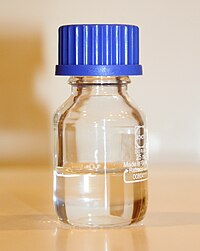
Photo from wikipedia
Tertiary alkyl, aryl or amino phosphines PR3 (R = Me, nBu, C2H4CN, NEt2) and the bis[(2-diphenylphosphino)phenyl]ether (POP) were allowed to react with fluoroiodomethane to produce fluoromethyl phosphonium salts in yields… Click to show full abstract
Tertiary alkyl, aryl or amino phosphines PR3 (R = Me, nBu, C2H4CN, NEt2) and the bis[(2-diphenylphosphino)phenyl]ether (POP) were allowed to react with fluoroiodomethane to produce fluoromethyl phosphonium salts in yields between 60–99%. The compounds were characterized by vibrational and NMR spectroscopy and in most cases also by single crystal X-ray diffraction. Diphenyl(fluoromethyl) phosphine was synthesized as a mixed aryl–alkyl-phosphine and the TEP value (Tolman electronic parameter) was determined in order to explain its low reactivity. The molecular and crystal structures of the new fluoromethyl phosphonium salts [R3PCH2F]I with R = Me, C2H2CN and NEt2 as well as of the salt resulting from the fluoromethylation of POP provided additional information on the structural behavior of the bioisoster CH2F group bonded to phosphorus. Hydrogen bonding in the crystal is compared with that observed in the crystal structure of PPh3CH2FI. The toxicity of the sufficiently water soluble salt [Me3PCH2F]I was investigated and the toxicological effect of the CH2F group was compared to that of the bioisoster CH2OH group in THPS.
Journal Title: New Journal of Chemistry
Year Published: 2020
Link to full text (if available)
Share on Social Media: Sign Up to like & get
recommendations!